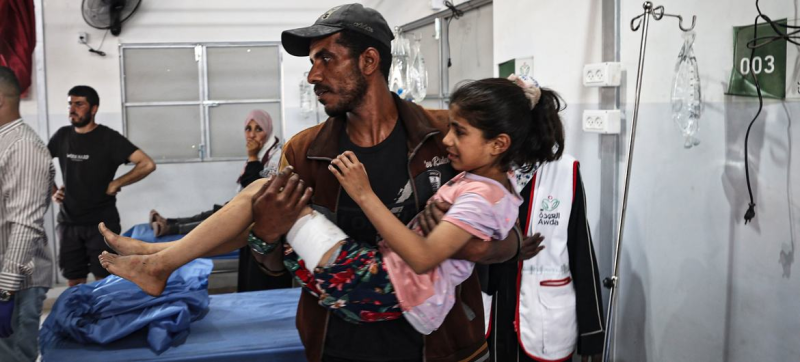- CA Yunus pays homage to Liberation War martyrs on Victory Day |
- Bangladesh capital market extends losing streak for second day |
- Bangladesh celebrates Victory Day Tuesday |
- 'Different govts presented history based on their own ideologies': JU VC |
Gaza horrors continue as weakest succumb to injuries, disease

A 10-year-old girl is carried into the Al-Awda Hospital in Nuseirat camp, Gaza.
Death and suffering in Gaza are ever-present, and the enclave's people now have little choice but to risk their lives to fetch aid supplies, UN agencies said on Friday.
“I met a little boy who was wounded by a tank shell at one of these sites on the final day of me leaving Gaza – I learnt that this little boy has since died of those injuries,” said UN Children’s Fund (UNICEF) spokesperson James Elder. “That speaks to both what is happening at these sites and what is not happening when it comes to medical evacuations.”
A recent online video featuring a dying 13-year-old Abed al-Rahman, whom Mr. Elder met while on mission in Gaza, has been seen thousands of times since it was published on 6 June. In the clip, Abed explains that he has been asking for pain relief for his shrapnel wounds, but none is available.
Speaking to journalists from Amman, Mr. Elder explained that partly destroyed hospitals, including Nasser Medical Complex in Khan Younis, continue to treat wounded children despite a shortage of medicine and medical supplies.
“Humanitarian aid is so much more than food in a box; it's oxygen kits, it's ventilators, it's hygiene packs; it's medicines, it's incubators,” he explained. “It's all those things the United Nations was doing just a couple of months ago.”
Mr. Elder added that parents whose children need oxygen have been leaving hospital “because of the fear that Nasser may come under attack again. As the doctors told me, if you have a child who needs oxygen and they leave without the oxygen, they will, over a matter of time, die in a tent.”
The dire shortage of the most basic life-sustaining aid linked to Israeli restrictions continues to create desperation and starvation across Gaza.
“I spoke to a grandmother in tears saying, ‘How am I possibly to get to these sites?’” Mr. Elder explained. “I've met young men who've been seven times and never returned with anything. So, there's a complete lack of equity. There's a complete lack of sites. You cannot distribute aid in a militarised zone, in a combat zone, by one party to the conflict.”
Those most susceptible to the lack of fresh drinking water, food, and fuel are the weakest Gazans: the young, pregnant women, the elderly, and amputees, Mr. Elder said.
It would be impossible for them to walk the long distances required to fetch scant supplies from controversial non-UN aid hubs.
“You have half a million people facing starvation with a lethal choice of being forced into very small pockets where most people can't access what are officially known as combat sites,” the UNICEF spokesperson explained. “We know children [who have been] killed at these sites.”
Meanwhile, malnutrition and its impact on people’s weakened immune systems continue to take their toll, the UN World Health Organization (WHO) warned.
“The latest reports say 610 patients have been admitted due to severe malnutrition complications,” said WHO spokesperson Christian Lindmeier. “But what does that mean? That means these are the lucky ones who made it so far to get to a place.
"This does not count the many who were too weak to reach any point, who cannot be transported because the roads are blocked, because there are no ambulances, or because the hospitals—some of the health emergency centres—have been shelled and bombed and are being constantly shelled and bombed.”

